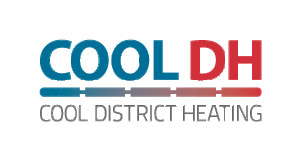The consortium organised the innovation process and developed new innovative solutions that will be demonstrated on-site.
It developed new DH pipes offering new characteristics in the following fields: use of PE-RT plastic material instead of PEX and steel; improved insulation material; integrated oxygen and vapour barrier; weldable coupling methods; leak detection system; higher flexibility; and larger dimension than normal PEX.
On this page you can download reports and working papers on innovations within the COOL DH-project. The main focus is to propose and to develop integrated smart city LTDH system solutions and system optimisation.
New innovative main line with heat recovery
On the demonstration site in Høje-Taastrup municipality a new type of multimedia pipe system with heat recovery has been installed in the distribution network. The product developed shows that it is possible to integrate collector pipes in standard district heating pipes to recover heat and minimise heat loss.
Central production system (CPS) – producing heating and cooling as well as surplus heating for the LTDH grid
This deliverable focuses on the heat recovery system installed at MAX IV facility, which aims to recover the heat produced by the cooling system and supply it to the new district heating network in Brunnshög district.
Prototype for new multimedia pipe types for LTDH distribution system
This deliverable investigates the possibility of implementing a heat recovery system in the distribution pipes of a district heating network. The aim with the multimedia pipes is to minimise the heat losses from the distribution pipes.
Draft design manual for new pipe components for LTDH distribution systems underground
The implementation of LTDH network and the development of the DH pipes production allow the use of in flexible plastic pipes also for main lines. This deliverable provides the draft of the installation manual of the new pipe components for LTDH distribution systems in Høje-Taastrup and Lund.
Calculator on savings for new high-efficient pipe types for internal distribution in buildings
This deliverable presents the calculation tool and guidelines for calculating the heat loss from the distribution pipes in buildings. The tool was developed with Microsoft Excel.
Continue to download calculator
Improved use of individual metering concepts
In this report we provide an overview of regulations on district heating metering and billing in Sweden and Denmark. It also provides an overview on applications to use on customer’s meter readings for energy efficiency improvements.
Technical specifications for substation solutions for single family units
In the new generation of district heating networks, the lower supply temperature reduces the heat losses in the distribution network, reaching a higher efficiency of the system. However, reduced temperature increases the risk of Legionella contamination in domestic hot water systems. This report aims to give an overview of the technical solutions that can be implemented in low-temperature district heating networks and fulfil the energy and the safety requirements of the users.
Working paper on result of optimization using smart meters
This working report is to be used for analyzing results of heat usage optimization using smart meters called “Optimizer” in a building block in Kämnärsrätten area of Lund. Using a smart control system can help to optimize the heat usage to reduce return temperature, emissions, and primary energy use and of course, bill payments.
Working paper on optimising cascade couplings for optimal use of low temperature sources
This report studies parameter variations of cascade couplings of heat pumps used to produce district heating based on low temperature heat sources of 7-23°C. The study concludes that the way to reach high energy performance is to put effort into several various aspects. When combined, these efforts will combine into large potential energy savings.
Working paper on LTDH connected appliances – washing machines, dishwashers etc. eliminating electricity topping of temperature.
Kraftringen and COWI A/S have produced this report that shortly describes the technology and history of HWC (Heating Water Circuit) appliances, as well as traditional dishwashers that are connected to hot tap water and washing machines with both hot and cold water connections. The appliances are evaluated in the context of LTDH (Low Temperature District Heating).
Report on solutions for avoiding risk of Legionella
Low temperatures in domestic hot water systems increases the risk of growth of Legionella bacteria which if inhaled can cause Pontiac fever or Legionnaires’ disease. Lund University, Kraftringen and COWI have worked on a report that investigates solutions for avoiding risk of Legionella when using LTDH.
Development of short time and seasonal energy storage
Høje Taastrup District Heating and COWI A/S have examined the potential of a short time and seasonal energy storage in the municipality of Høje-Taastrup. The storage will be established as an ATES plant.
Solutions for local integration of renewable energy sources (RES)
This deliverable summarizes and gives an overview of existing and newly developed technical solutions used for the domestic hot water production that can be implemented in low temperature or ultra-low temperature district heating networks, and that can increase the share of renewable energy in the building sector.
System solutions for multifamily houses and tertiary buildings
The pipe heat losses in the circulation of domestic hot water (DHW) can be high in comparison to the demand and use of DHW. Flat stations can be used in order to potentially lower these heat losses. Kraftringen, COWI A/S and Cetetherm have looked closer on solutions with flat stations in buildings with low district heating (LTDH).
New design concepts for optimisation of LTDH distribution systems
The purpose of this report is to explain the design process that can lead to the reduction of the heat losses in a district heating system as well as to present the main factors that affect the heat losses. In particular, the factors considered are; improved pipe insulation, use of twin pipes, reduced pipe size, reduced pipe length and the distribution principle in between the buildings.

